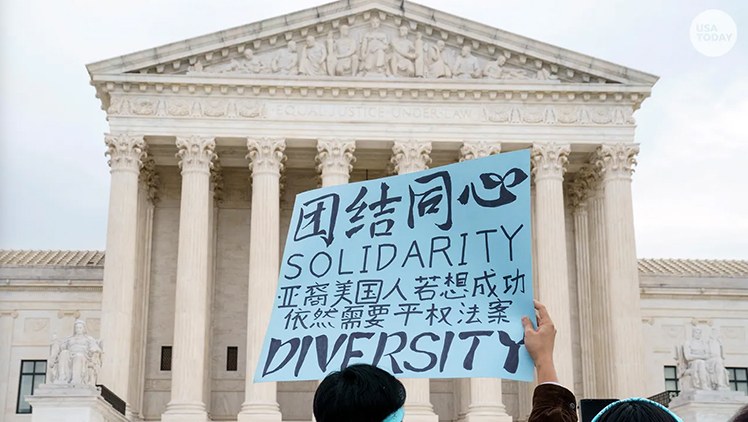Pierre is a leading college and graduate admissions consultant with extensive experience in education and entrepreneurship. His advice has been featured on Forbes.com, U.S. News, CNN Business, the Washington Post, ABC News, Business Insider, and more.
The US Supreme Court’s recent decision to reject the use of affirmative action in university admissions will change the way colleges and universities evaluate student applications and may also alter the makeup of college campuses across the country.
On February 2, 2023, we here at H&C published a breakdown of the then-pending U.S. Supreme Court cases that concerned the issue of affirmative action policies, a practice that grants special consideration to historically-excluded groups, specifically racial minorities and women, in the college admissions process. These lawsuits were brought against Harvard University and the University of North Carolina by a group known as the Students for Fair Admissions (SFFA), alleging that the practice allowed for racial discrimination.
Then, on June 30th, 2023, the Supreme Court released a landmark ruling: they had determined that the consideration of race in the college admissions process did violate the Constitution, specifically the Equal Protection Clause in the first section of the Fourteenth Amendment.
In this article, we break down the Supreme Court’s decision and the implications it will have for colleges and universities, particularly for future applicants.
Table of Contents
The Supreme Court’s Decision in Both SFFA Cases
The court was considering two cases concerning the issue of affirmative action, as mentioned above, brought forward by conservative legal strategist Edward Blum on behalf of SFFA. The cases questioned whether or not Harvard University discriminated against Asian-American applicants in its admissions process, and whether or not the University of North Carolina at Chapel Hill gave preference to Black, Hispanic, and Native American applicants over white and Asian applicants.
The court ultimately decided that the practice colloquially known as affirmative action should be deemed unconstitutional. They ruled 6-3 in the University of North Carolina case and 6-2 along ideological lines in the Harvard case, since Justice Ketanji Brown Jackson recused herself because of her position on Harvard’s board of overseers.
Chief Justice John Roberts wrote the majority opinion, along with Justices Clarence Thomas, Samuel Alito, Neil Gorsuch, Brett Kavanaugh, and Amy Coney Barrett. Thomas read a concurring opinion from the bench, and both Brown and Justice Sonia Sotomayor read their dissents aloud (Brown’s solely for the UNC case), with Sotomayor declaring that the decision “stands in the way and rolls back decades of precedent and momentous progress.”
Roberts wrote the following in the majority opinion: “The Harvard and UNC admissions programs cannot be reconciled with the guarantees of the Equal Protection Clause. Both programs lack sufficiently focused and measurable objectives warranting the use of race, unavoidably employ race in a negative manner, involve racial stereotyping, and lack meaningful end points. We have never permitted admissions programs to work in that way, and we will not do so today.”
In his concurring opinion, Justice Thomas uses the term “race-neutral” to describe the alternative to race-based admissions. He wrote that race-neutral policies can “achieve the same benefits of racial harmony and equality without any of the burdens and strife generated by affirmative action policies.” (Justice Sotomayor rejected this idea, saying that “racial inequality will persist so long as it is ignored.”)
It’s important to note that several states have already repealed affirmative action programs for their public universities — these states are California (1996), Washington (1998, rescinded 2022), Florida (1999), Michigan (2006), Nebraska (2008), Arizona (2010), New Hampshire (2012), Oklahoma (2012), and Idaho (2020). This means this ruling is applying to private colleges and private universities in those states for the first time, while the public universities have already seen the impact of the repeal of the practice. Affirmative action was also effectively banned in Louisiana, Mississippi, and Texas until Grutter v. Bollinger, another landmark Supreme Court case concerning affirmative action, abrogated it in 2003.
How will this decision affect future college applicants?
If you are a current high school student, especially a rising high school senior, or a parent of a high schooler, you’re likely wondering how this will affect your upcoming college applications and subsequent college experience — read on to learn more about how this may affect you or your child.
The Impact on College Applications
Technically speaking, applicants’ approach to college applications will remain fundamentally the same — what’s changing is how the discussions of race will take place amongst admissions officers, particularly as it pertains to the overall racial diversity of the schools’ respective student bodies.
In the court’s majority opinion, Justice Roberts wrote: “Nothing in this opinion should be construed as prohibiting universities from considering an applicant’s discussion of how race affected his or her life, be it through discrimination, inspiration, or otherwise… But, despite the dissent’s assertion to the contrary, universities may not simply establish through application essays or other means the regime we hold unlawful today.”
So, students will be able to describe experiences with racism and racial identity in their own life experiences in their applications, which is allowed to figure into the discussion of their candidacy. However, the race of applicants, simply from an objective, demographic standpoint, cannot figure into the admissions decision. It’s important for students to know how this information is considered so they can present themselves in the best possible light.
This is somewhat similar to the way that many admissions processes are need-blind when it comes to finances — admissions officers won’t know about a student’s financial need, but they could make inferences from essays about a student’s level of wealth (although these inferences are, theoretically, not a factor in admissions decisions).
He proceeded to give several examples of how universities could consider essay and short answer question responses that mention a student’s race: “A benefit to a student who overcame racial discrimination, for example, must be tied to that student’s courage and determination. Or a benefit to a student whose heritage or culture motivated him or her to assume a leadership role or attain a particular goal must be tied to that student’s unique ability to contribute to the university. In other words, the student must be treated based on his or her experiences as an individual—not on the basis of race.”
It’s also important to note that this outcome has spurred another lawsuit concerning the issue of legacy admissions, which is still in effect at many elite colleges. Lawyers for Civil Rights, a nonprofit based in Boston, filed a lawsuit challenging Harvard “on behalf of Black and Latino community groups in New England, alleging that Harvard’s admissions system violates the Civil Rights Act,” according to AP. If you’re interested in learning more about the impact and history of legacy admissions, read our recent blog post on the subject here.
But this implies that there will be many ensuing changes in the college admissions process from here on out, especially with regards to the most controversial practices.
The Impact on College Campuses & Student Bodies
Statistics suggest that the repeal of race-conscious admissions nationwide will be a blow to racial equality and diversity in higher education. Many experts are suggesting that this will lessen the amount of quality education accessible to minority groups and decrease the amount of diversity on college campuses.
The dean of the UC Berkeley School of Law, Erwin Chemerinsky, said the following regarding the aftermath of Proposition 209, which ended affirmative action in California: “There was an immediate devastating effect on diversity. The number of Black and Latinx freshmen at UCLA and Berkeley fell by 50%. But through concerted efforts, and much trial and error, the UC schools found ways to achieve diversity without affirmative action. It took a long time. UCLA did not achieve its pre-1996 level of diversity until 2015.”
There are, however, certain ways that universities and colleges can implement internal strategies to ensure talented students of color are given a level playing field. Elite universities and selective colleges like Harvard College have reaffirmed to their communities that “diversity and difference are essential to academic excellence,” implying that race-conscious college admission practices could still be implemented using the legal loophole Roberts offered in the majority opinion.
The downside is that it just may take a while, which will affect underrepresented minority student groups for generations of students to come in the interim. And none of the possible solutions are very simple either.
In an interview with PBS News Hour, University of Michigan President Santa Ono described the practices they’ve used to ensure diversity on campus since the state-wide ban in 2006: “We have been using multiple strategies, a holistic review, Pathways programs, and really looking for low-income, high-ability, and first-generation students to build a diverse class. It has taken a lot of time. We lost a lot of ground when affirmative action was banned. But we’re really making significant progress right now with those mechanisms.”
Wherever you fall on the issue of this issue, there is no doubt that the affirmative action ruling will change the landscape of higher education and college admissions for the foreseeable future. By keeping abreast of these issues, you’re setting yourself up for the best possible experience as a college applicant and future student.
If you need help creating the right strategy for the application process, contact us today to set up a free consultation with one of our college counselors.




